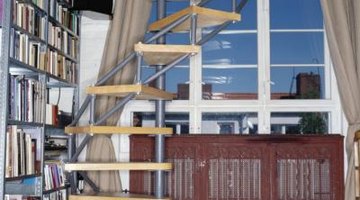Advantages & Disadvantages of Spiral Stairs
Spiral stairs bring to mind long, winding staircases in medieval castles or perhaps an elegant feature of an expensive house. Today, spiral staircases are more frequently seen and can make a useful addition to the typical home. They have their advantages and disadvantages, which you should consider carefully before making any decision to install one.
Space

Perhaps the primary advantage spiral staircases have over regular stairs is their space-saving capabilities. For example, a straight staircase that is 18 feet high and 3 feet wide fills 105 square feet of space, while a spiral staircase of the same proportions fills only 45 square feet of space. The smaller amount of space required by spiral stairs also means they rarely dominate a room, which sometimes happens with straight and L-shaped stairs.
Limitations
Spiral staircases have more limited uses than other types of stairs. You cannot use them as the sole means of access to an full upper story, because building codes prevent such construction. You also cannot move most large pieces of furniture up and down the typical spiral staircase. They don't work well as the sole means of entry to a basement, because you might need to take large appliances, such as a furnace, down the stairs.
Indoor and Outdoor
Many people like the look of spiral stairs and feel they give an air of romance to a room or space. When built indoors, they create a good means of providing entry to lofts. Spiral stairs often work well in outdoor settings, such as fire escapes, and to give access to areas such as widow's walks. They have a long history of indoor and outdoor use in commercial applications, such as accessing catwalks and skywalks.
User
A spiral stair case has both advantages and disadvantages for the user. Spiral stairs that center around a vertical pole typically have a railing only on the side opposite the pole. Users can easily miss a step if they walk on the side without a rail, especially when going downstairs. However, if a user falls on a spiral staircase, he is much less likely to fall all the way down the to the floor, as he might on a straight staircase, because the curve of the stairs will break his fall.
References
Writer Bio
Mark Pendergast has worked as a freelance writer since 2007, focusing on topics such as health, sports and finance. He has worked as a newspaper reporter and librarian and has written for the "Northside Sun" and "Jackpot," among other publications. Pendergast holds a Bachelor of Arts from Millsaps College.
Photo Credits
- Ryan McVay/Photodisc/Getty Images
More Articles



